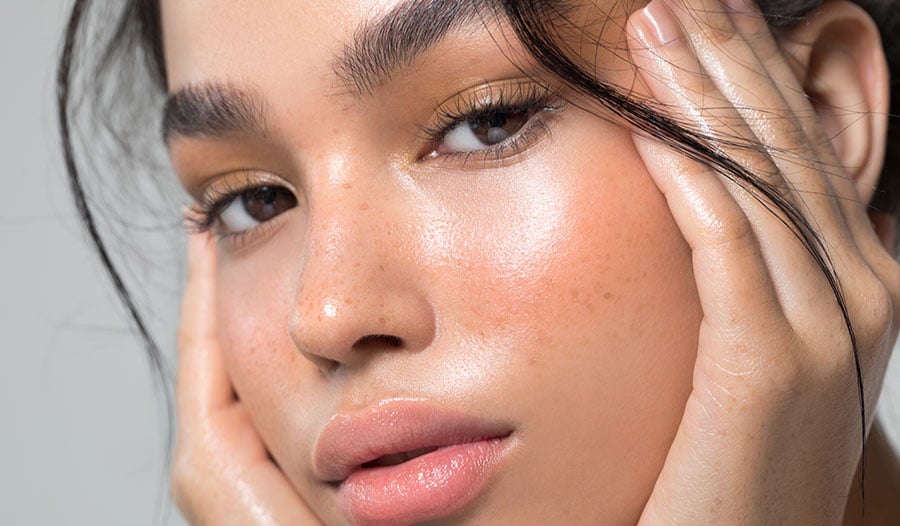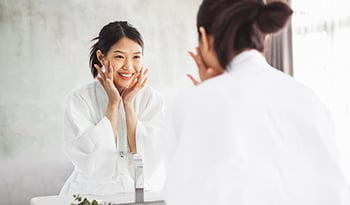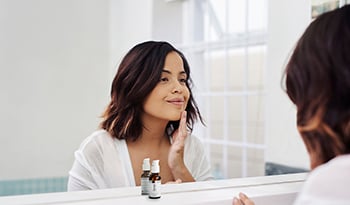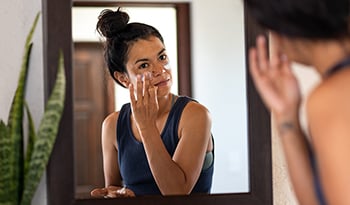How to Heal and Conceal Rosacea
DISCLAIMER:This blog does not intend to provide diagnosis...
- In this article:
- How Is Rosacea Different From Sensitive Skin?
- What Are the Root Causes of Rosacea?
- How to Heal Rosacea Topically
- How to Heal Rosacea from the Inside Out
- How to Conceal Rosacea

Rosacea is a skin condition that usually presents with redness that extends across the nose and cheeks. It can also include increased flushing (blushing), papules and pustules, dry skin, changes to the skin on the nose, and signs of vascular inflammation. It can also involve the eyes.
How Is Rosacea Different From Sensitive Skin?
Sensitive skin tends to react to things that are put on it. Redness and bumps can be part of this reaction, but it’s temporary and can be fixed by avoiding the offending substances.
Rosacea is different in that the cause is medical and often internal. While rosacea can be aggravated by topical lotions, creams, and washes, it does not resolve when these items are removed and requires additional treatment to heal the root cause.
What Are the Root Causes of Rosacea?
Rosacea is still poorly understood, but there are a number of mechanisms and infections that we do know are associated with the disorder. First, people with rosacea have higher levels of inflammatory mediators like mast cells, lymphocytes, immune cells, and antimicrobial proteins in their skin. Secondly, infections like H. pylori, small intestinal bacterial overgrowth, and higher numbers of skin mites are found in people with rosacea. There is also a degree of vascular inflammation or hyperreactivity found in rosacea, which essentially means that blood vessels are more likely to react to external stress in people with rosacea than people without it.
It’s uncertain what types of genetics are exactly involved in rosacea, but we do know that people with a family history of rosacea are more likely to develop it at some point in their lives and that the VEGF gene may be involved. Coffee consumption, smoking, UV exposure, and alcohol consumption also appear to increase the risk of developing rosacea. Rosacea is associated with a higher risk of gastrointestinal diseases, metabolic disorders, depression, and neurologic disorders. This may be because these disorders also involve dysbiosis/microbiome pathologies, altered vascular function, and inflammation.
How to Heal Rosacea Topically
There are a number of lifestyle and topical treatments for rosacea. The first is to eliminate extra aggravating factors that can make rosacea worse. Doctors advise people with rosacea to use non-irritating skin creams and washes, sun protection, and lotions. This can be accomplished by buying hypoallergenic skincare products, including scent-free lotions and face washes for sensitive skin. People with rosacea should also use hypoallergenic shampoos and conditioners to avoid flare-ups, since these products come into contact with the face. Hypoallergenic sunscreens should be used as well.
Prescription Lotions and Creams for Rosacea
Prescription topical treatments for rosacea usually include antimicrobial and anti-inflammatory prescription creams to help control symptoms like metronidazole. Talk with your doctor about which may be right for you.
Non-Prescription Lotions
Rosacea involves vascular inflammation and immune activation. I often recommend cooling gels like aloe vera for my folks with rosacea because, from an eclectic herbal perspective, it should in theory help to draw some heat out of the skin and can’t hurt. There is some data that lotions that contain licorice root may also be effective in reducing symptoms over a 4-week period. These lotions should be part of a symptom-reduction plan, not your only approach, because topical non-prescription lotions rarely heal rosacea on their own.
How to Heal Rosacea from the Inside Out
In order to heal rosacea, the best bet is to heal it from the inside out.
Heal the Gut, Heal Rosacea
Natural approaches to healing rosacea include a comprehensive gut-healing protocol if necessary, including the use of antimicrobial herbs to eliminate infections or dysbiosis, probiotics, glutamine supplementation to heal compromised gastric tissues, and digestive enzymes. The unique combination of these approaches that you use will depend on your unique root cause. You should work with your doctor, herbalist, naturopathic doctor, or gastroenterologist to determine what specific approach you need to heal your gut.
Increase Antioxidants to Heal Rosacea
Additionally, those with rosacea should focus on optimizing the health of blood vessels with a diet/routine high in antioxidants, anthocyanins, vitamins, and minerals. Antioxidants help to protect endothelial cells from oxidative damage. Endothelial cells line our blood vessels and help regulate their function, as well as prevent plaque formation. Keeping them healthy can help to reduce the vascular issues we see in rosacea, such as flushing and telangiectasia or visible blood vessels under the skin. Antioxidants come from plant foods like fruits and vegetables, so eating more of these foods is a safe, healthy, and delicious way to help heal your rosacea from within.
How to Conceal Rosacea
Use Moisturizer First
Before using a primer, wash and moisturize your face using a hypoallergenic wash and lotion made for sensitive skin. After the moisturizer dries/settles into your skin, apply a green primer or concealer in thin layers and let dry.
Use Primers and Concealers with Green Tint Next
Doctors, dermatologists, cosmetologists, and make-up artists all agree—use green-tinted products to hide redness associated with rosacea. You can do this by using a green primer or green concealer under a full-coverage concealer. This works because green and red are complementary colors—when mixed together they tend to neutralize the non-neutral tones that each contains.
Use a Full-Coverage Foundation Last
Sheer concealers and tinted moisturizers will allow you to see through to the bottom layer of your makeup, which might include some shades of green if you performed the above steps. To avoid this, choose a full-coverage foundation or CC cream to apply over the green primer/moisturizer. You can apply in thin layers and let dry to avoid caking.
If you’re not used to wearing makeup, it can be easy to throw on a green primer, some foundation, and go. But taking an extra minute to add some highlights or contours to your face will take your makeup look from “just okay” to extraordinary! If you’re not sure how to apply these looks, consider hiring a professional makeup artist, or check out some tutorials on YouTube, Instagram or TikTok. With these tips and tricks, you can heal your rosacea from the inside out and look great while doing it.
Resources:
- Bhargava, Rahul, et al. “A Randomized Controlled Trial of Omega 3 Fatty Acids in Rosacea Patients with Dry Eye Symptoms.” Current Eye Research, vol. 41, no. 10, 6 Apr. 2016, pp. 1274–1280, pubmed.ncbi.nlm.nih.gov/27050028/, 10.3109/02713683.2015.1122810. Accessed 14 Sept. 2021.
- Hoffmann, Julia, et al. “New Herbal Biomedicines for the Topical Treatment of Dermatological Disorders.” Biomedicines, vol. 8, no. 2, 8 Feb. 2020, p. 27, 10.3390/biomedicines8020027. Accessed 11 May 2020.
- “Management of Rosacea.” Uptodate.com, 2021, www.uptodate.com/contents/management-of-rosacea?search=rosacea&source=search_result&selectedTitle=1~43&usage_type=default&display_rank=1. Accessed 13 Sept. 2021.
- “Rosacea: Pathogenesis, Clinical Features and Diagnosis.” Uptodate.com, 2021, www.uptodate.com/contents/rosacea-pathogenesis-clinical-features-and-diagnosis?search=rosacea&source=search_result&selectedTitle=2~115&usage_type=default&display_rank=2. Accessed 13 Sept. 2021.

 By Dr. Kate Henry, N.D.
By Dr. Kate Henry, N.D.


